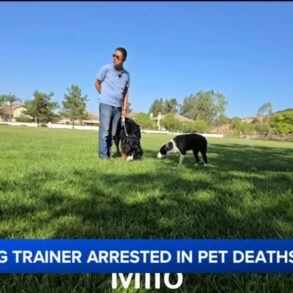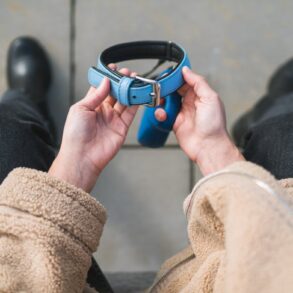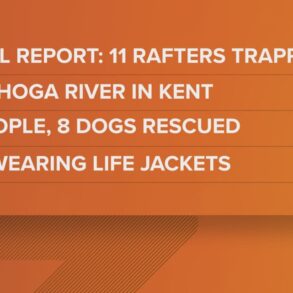There are expected to be 100 million dogs in America by 2030. The canine population here keeps going up — and the culture around dogs keeps changing. Today, they’re often just as commercialized as the rest of us, from a $3,000 Gucci dog carrier, to Vogue Magazine’s newest version catering to dogs, Dogue.
But, Maddy Butcher, a contributing opinion columnist for the Washington Post, has a different idea of what is ‘essential’ for dogs.
Butcher writes about the rural West and in a recent column, she talks about what dogs really need: To run, sniff, play. You know, to be dogs. And that’s hard for them to do when they’re locked up in an apartment or house for most of the day.
Butcher lives in Montezuma County, Colorado and splits her time between writing and day working for a rancher. That means everything from fixing fences to moving cattle with her dogs. Butcher joined The Show to discuss.
Full conversation
MADDY BUTCHER: l have three working dogs. One is a young puppy, he’s just turning 1, and he’s coming up with his mentors as I see it, older dogs: a 3.5-year-old and a going-on 8-year-old, and they are all Border Collie mixes. None of them are purebreds. They’re kind of known, in this area anyway, as ranch dogs.
LAUREN GILGER: And they work, right? Like this is part of your work, they are.
BUTCHER: Yes, they have a job.
GILGER: So I want to ask you to set up your argument that you’re making here about someone you profile in the piece a little bit, someone who owns a sled dog business: Gregg Dubitt. Tell us about him and, and sort of the criticism that he has faced and the criticism that he has.
BUTCHER: Gregg and his wife are over just east of me by 30 miles or so. And they have 28 sled dogs and they train their dogs off season. But then during the season, they are working them as sled dogs.
Most of the dogs stay outside year round and through the four seasons, and those dogs have jobs too. The sled dog community has faced criticism from animal welfare groups like PETA because, as in any industry, there are a few bad apples. There was a sled dog kennel operation that faced some disciplinary action because of poor treatment.
And I guess it’s inevitable that operations like that will come under scrutiny and some will be bad apples and rightly so. I mean, you can’t neglect or abuse your animals.
However, I think a lot of animal welfare groups may or may not be educated in terms of what those specific dog needs are. And for instance, l’d say most ranch dogs don’t need to have a dedicated dog bed or a couch or stay inside. And if you were able to get into a dog’s mind and ask them what their best interests are, they’d say “No, I don’t want to be inside.”
The disconnect, I think with a lot of animal welfare groups and a lot of people who are buying accouterments for their dogs is that they are falling to know the dogs well enough — biologically, physiologically, if you want to say psychologically — know them enough to know actually what their needs and wants are. And rhinestones is probably not high on a dog’s list, right?
GILGER: This is so antithetical to the way that we think about our dogs in this country. And you write about the sort of dog version of Vogue and the amounts of money people are spending on things for their dogs. But beyond that, there’s a criticism. What about all these dogs who are locked in houses for a very long time?
You have this line in the piece I want to read where you write, “Towns, cities and nonprofit animal welfare organizations have done a good job of establishing dog shelters and supporting adoption.” This is all good, right? “But,” you write, “how many dogs are saved from euthanasia, starvation, neglect, abuse or exposure only to die of boredom and obesity?” Tell us about that.
BUTCHER: That line was inspired by a cartoon that I saw years ago. The image of a dog looking out the window and its owners are staring at a TV and slumped on a couch. And the caption is, “Was I rescued only to die of boredom?” And granted,, that’s anthropomorphizing itself, obviously.
But I do think that people get into dog ownership to satisfy very human needs. They feel good because they may have rescued a dog from a pound or a shelter. And yet they go into the dog ownership lacking the education of what dogs really need.
And I got an email after that Washington Post column of a woman in downtown Denver who watched as she called them “young professionals” rush out with their dogs on a leash for their 30 minutes of exercise coming out of tiny apartments to the cartoon’s endpoint. It’s unfortunate that I think a lot of us have put their interests and a certain lack of knowledge in front of the best interests of the dog.
GULGER: So what you’re kind of talking about — and you mentioned this earlier in the conversation — is this idea of putting yourself inside the dog’s head a little bit and understanding those breeds, what they were bred for, what they are kind of meant to do. Tell us a little bit about that.
Like your dogs as an example, tell us about how they were bred, what they are meant to do and what they would be like if they lived in a city in an apartment and got 30 minutes outside a day.
BUTCHER: So Border Collies and stock dogs in general, they have a very strong drive to move prey animals specifically, anything from sheep to ducks to goats to cows. In terms of a dog that has that drive in the city, where is the outlet for that?
And as I mentioned in the Washington Post piece, pretend jobs are fine. I don’t think I would own a stock dog if I lived in the city. But if I had one, I would give it jobs, whether it meant herding my cat around or herding ducks around in my backyard to running with it or just games of fetch or something that stimulates not only its mind but its body.
GILGER: So let me ask you this. And this is a tough question, but you’re getting out of here. Hundreds of millions of people have dogs in America, and we love them in a way and maybe we don’t understand them, maybe we aren’t doing it right. But are there ways in which you can live in urban America with the dog and do it well and like care about the dog’s needs, even though they may need to be in an apartment for many hours a day.
BUTCHER: That’s a really good question. I would do research around what dog is best suited to that. It certainly wouldn’t be a sport dog or a working dog. And that’s hard to do in the rural West, for instance, even if you go to the shelter, almost all the dogs are working dogs.
So I feel like you really have to balance your interest in helping in adopting and rescuing with a certain level of education around not what’s going to be good for me, the human, but what’s going to be good for this specific dog.
The main pushback that I feel like Phoenix listeners would be giving me is that we simply cannot get outside, and we don’t have open space, and we don’t have a climate that is amenable to lots of racing around. And I would say, OK, let’s try to be part of the solution, which would be something indoor, perhaps? A big open arena with Astroturf and an understanding that dog owners are going to pick up after their dogs, as well as something that has water where they can cool off.
But I guess that I tend to look at dog ownership problems as challenges that can be overcome. And that where there’s a will, there’s a way.
KJZZ’s The Show transcripts are created on deadline. This text is edited for length and clarity, and may not be in its final form. The authoritative record of KJZZ’s programming is the audio record.
This post was originally published on this site be sure to check out more of their content.












































